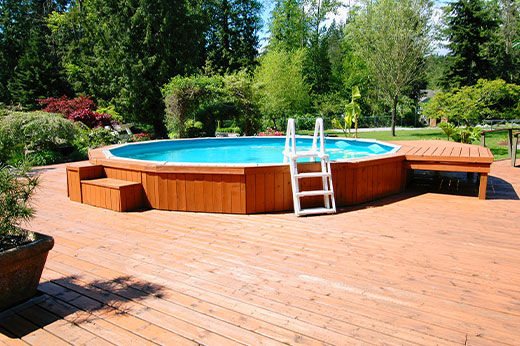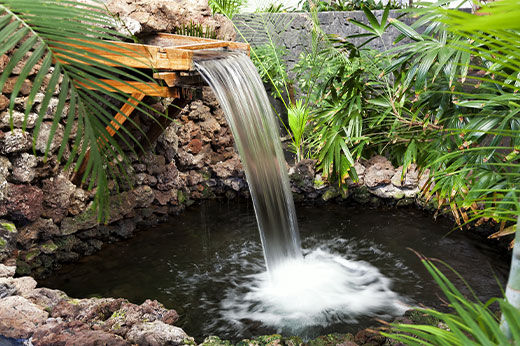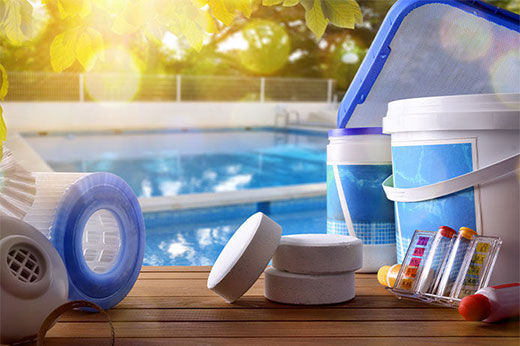While do-it-yourself projects can be fun and fulfilling, there is always a potential for personal injury or property damage. We strongly suggest that any project beyond your abilities be left to licensed professionals such as electricians, plumbers, and carpenters. Any action you take upon the information on this website is strictly at your own risk, and we assume no responsibility or liability for the contents of this article.
How to Add Chlorine To Pools
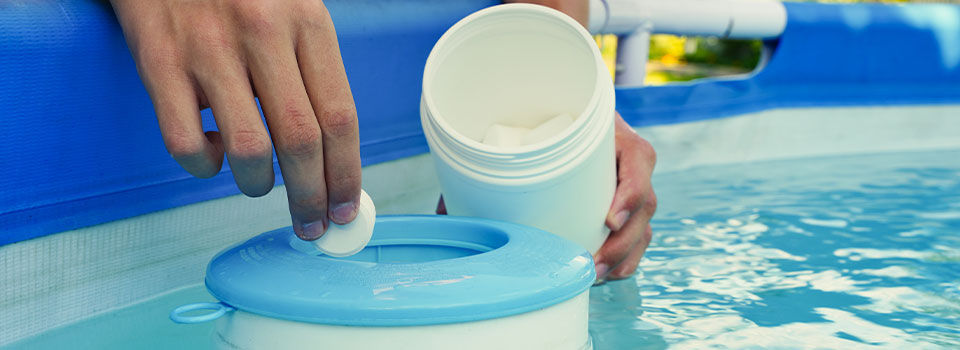
A backyard swimming pool is the secret to getting the most out of summer. You can cool off any time you like without driving to a recreational center or lake. While installing an in-ground pool may be the work of a professional, maintaining any type of backyard or indoor swimming pool can be a DIY job.
By learning how to add chlorine to your swimming pool, test the water, and keep your pool healthy, you’ll save money. What’s more, you’ll maximize your enjoyment with the reassurance that your pool is safe, clean, and well-maintained.
Why Do Pools Need Chlorine?

Besides cleaning out any wayward debris visible in your pool, you can keep your pool well-maintained by covering it whenever it isn’t in use. But covering and removing debris isn’t enough to keep standing water healthy.
Any time you have a body of water, microorganisms, bacteria, and algae can build up and make the pool not-so-appealing. Treating a pool with Chlorine is particularly important because it kills bacteria that could make you sick.
What does chlorine do to a pool? When you add chlorine to your pool water, a chemical reaction occurs, and chlorine breaks down into two molecules—hypochlorite ion and hypochlorous acid. Chlorine kills microorganisms by breaking down the lipids within their cell walls.
It all comes down to pH. Our bodies have a pH between 7.35 and 7.45. Untreated water has a pH of 7. To be comfortable yet safe, pool water should register a pH between 7.2 and 7.8. The other important factor is the "free chlorine level." These levels should stay between 1-3 ppm for a pool and 2-4 ppm for a hot tub.
With the right pool testing kit, you can check your levels a few times per week to ensure that the pool is chlorinated enough to stay clean but not so heavily chlorinated that you and your family experience eye and skin irritation. Ultimately, it's always important to remember that chlorine is a strong chemical that you should always handle safely and carefully.
The Best Time to Add Chlorine to Your Pool
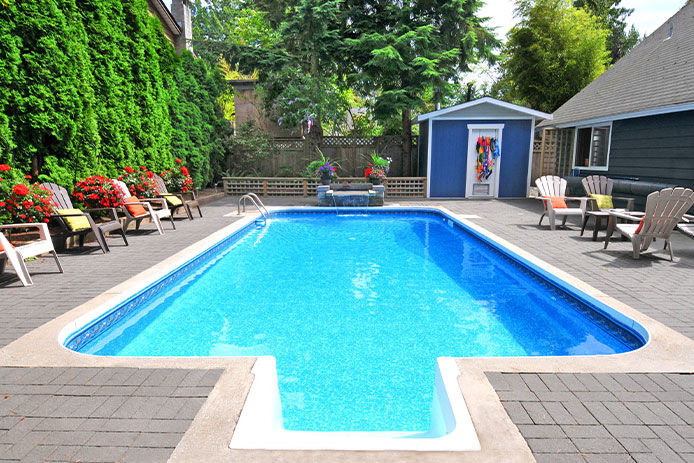
So the first question when it comes to adding chlorine to your pool is when? What is the best time to add chlorine to the pool?
Most chlorine pool treatments are stabilized, meaning they will work safely and continuously whenever added. That said, UV rays from the sun naturally break down chlorine when it's in the water, reducing its effectiveness.
When swimming, the human body also adds bacteria and oils to the water. Encouraging swimmers to rinse off any lotion, hairspray, and other cosmetics before jumping in will help your pool stay more balanced. It goes without saying that kids (and adults) should also take bathroom breaks outside the pool.
It's best to add chlorine to your pool at night, so it can work while no one is swimming and the sun has set. If you use a slow-dissolve chlorine treatment like a tab, adding it at night gives it time to dissolve, so the pool will be ready to face the day.
How Often to Add Chlorine to Pools
Test your pool regularly, every few days, and treat it as needed. Typically, you will need to add chlorine tabs or granules to your pool on a constant basis. About every two weeks, you will need to shock your pool with a higher dose of chlorine. This raises the pH levels quickly and is especially important in sunny weather when the chlorine can break down.
How to Add Chlorine to Your Swimming Pool

How do you add chlorine to your swimming pool? How much chlorine should you add? The amount of chlorine and the process depend on the form you use, the specific product concentration, the volume of your pool, and the current pH level.
For regular pool treatment, round up the volume to the nearest 5,000-gallon measurement to determine the amount of chlorine you need to add. Each product label will explain the proper quantity based on the targeted PPM.
How Long to Wait After Adding Chlorine to Pool
It’s safe to swim and use the pool while you’re adding chlorine or while the chlorine is dissolving as long as the latest reading shows that the measurements aren't under 1 PPM or over 4 PPM.
Make sure to use an automated pool chemical dispenser or floating cage for the chlorine to get it well-distributed throughout the pool’s water.
How to Shock Your Pool with Chlorine

Shocking a pool may sound like a significant job, but it's just part of regular pool maintenance. It's a process that involves adding more chlorine than usual (sometimes along with other chemicals) to address an imbalance in the pool.
How often should you shock a pool? It depends on many different factors. Shocking is part of the preparation when you first prepare your pool for summer use, if you haven't used your pool for a week or so, or if you haven't treated the pool for more than a week. If a pool is used heavily, you may also need to shock it regularly. Pools in sunny areas may require more frequent shocking as well.
Generally speaking, you will need to shock a regularly-used pool every few weeks. But it's essential that you test your chlorine levels to see if it's time to shock. If the pool water has fallen below 1 PPM (parts per million) of chlorine, you will need to shock it to bring it up to standard levels.
When you shock a pool, the chlorine level will rise to 5-10 PPM. This kills off any microorganisms and cleans the water. However, it’s important not to swim in the water until it tests safely below 4 PPM.
How to Shock Your Pool

If you need to shock your pool, it’s important to treat the pH balance first and ensure it's between 7.2 and 7.6. Chlorine will be mostly wasted if the pH balance is off. Powder or liquid is generally used for this step, but you'll need to mix it with some water in a bucket first to help it spread throughout the pool.
Add the amount recommended for shocking on the package of chlorine based on your pool’s volume. Each product has a different concentration of chlorine, so using a fixed amount may not provide an adequate effect. Aim for 120 grams of chlorine granules at standard intensity per 10 m3 of water. Apply the chlorine at the end of the day after everyone is done swimming. And check the water in the morning for its chlorine level.
How To Maintain Chlorine Levels In Pools

The key to keeping pool water safe, healthy, and adequately chlorinated is to test regularly. How often should you test your pool water? It's best to use a pool test kit to test every day or every other day if you use the pool at least 2-3 times per week. If you only use your pool occasionally, you can test weekly (but you may need to test a day ahead of use in case the water needs to be shocked).
Most tests require you to take a small amount of pool water and dip in a test strip or mix the water with certain chemicals. These tests are user-friendly and easy to perform on your own, especially when you do them regularly.
A good pool test should tell you both the water's pH and chlorine levels. Keeping the chlorine level balanced is nearly impossible without the proper pH. For safe use, pools need to stay around 1 to 3 PPM, and smaller bodies of water like hot tubs and spas must be about 4 PPM or higher. Once you notice a drop in the chlorine level, you must treat it to maintain the desired level. You should test after each dose to ensure you're at the desired level.
At Do It Best, we have all the supplies you need to maintain a healthy pool all summer long. Cool off and relax in your healthy, balanced pool without any worries about water contamination.
